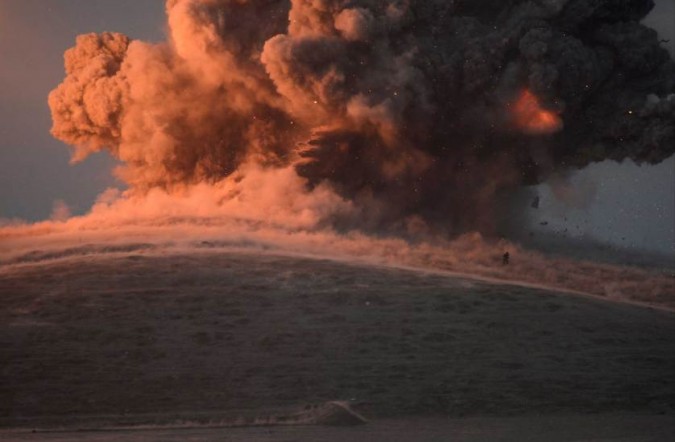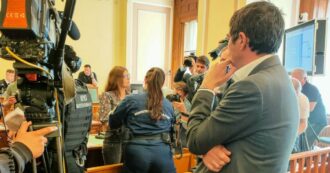They are here. The jihadists. Here, a few metres away. But the closest one I have seen, in Kobani, was a corpse: from the scope of a sniper’s rifle.
I come back here every day to watch the battle from the border, from Turkey. But more than on a hilltop, I feel like in a metaphor. Like this Bulent Kilic‘s picture. The blast, the airstrike, and that jihadist that runs, so small. It was taken with a giant telephoto lens. Since with the kidnappings, we have no other choice. We can only watch from a distance.
And the jihadists, from the distance, are only a black silhouette.
We have been here for three years now. And Isis, for us, it wasn’t something new, actually, something unexpected, but an evolution. We returned to Aleppo, every time, and the old bad guys were now the good guys, because somebody more hard-core than before, in the meantime, had arrived from abroad. And so, if at the start of 2013 we were all scared of the Ahrar al-Sham, the first jihadist group, in spring it was the Ahrar al-Sham that was defending us from Jabhat al-Nusra – that was soon defending us from Isis. On November 14, 2013, while the Ahrar al-Sham guys were restoring the electricity grid, the water pipes, replanting the trees, at al-Zarzous hospital Isis beheaded a patient: stunned from anesthesia, he was whispering Shiite verses. Only once the head was gone, they realized that he was one of them.
In these years, we have seen the fighters becoming more and more radical. Becoming more radical like the war – and more precisely, like Assad. Since at the beginning, it wasn’t but a matter of peaceful demonstrations, here. From batons, yet, the response quickly degenerated to bullets, and from bullets to mortars: from mortars to helicopters, and from helicopters to tanks, and then missiles, and jets, and gas – up to the barrel bombs. That are really cheap, they are just a mix of fuel and Tnt: and so they rain by the dozen. Every day. The only red line, here, in these years, it has been the wake left by the blood of the Syrians.
We have seen them radicalize together with our indifference.
Together with desperation.
But who is it now, for real, that black silhouette? It’s one like Giuliano Delnevo, you remember?, the 20 years old from Genoa converted to Islam, vulnerable, lost, with father and mother in endless fight, one that if he met the Hare Krishna, instead of Islam, today would be in the streets playing a drum, orange dressed? Or maybe it’s a fundamentalist like B., the German that promised to catch me and slit my throat because I wrote that Syrians, in Aleppo, aren’t talking anymore of liberated and occupied areas, of rebel-held Aleppo and regime-held Aleppo, but only of East and West Aleppo? Or maybe it’s one like I., the quiet Egyptian engineer that cooked me dinner a thousand times, worried that I lived out of biscuits, and found weird the fact that if someone stole my iPhone, I would have found a bit exaggerated cut the thief’s hand off? Who is that black silhouette? An opportunist like A., that sided with everyone, in his life, from regime to Isis, always loyal to the ruler of the day? Or a guy like M., one that overflows with hatred, brims over with rancor, one to which talking, honestly, is impossible, you feels like having a wall in front of you: one that lost basically everything, in this war, everything he had got bombed, everyone he knew got killed? One that is now totally alone? He had a Metallica hoodie when I first met him, he was a punk. Or maybe it’s like K., the Chechen that was fighting at the airport, who came in Syria because Russia, that supports Assad, exterminated his whole family. Or maybe it’s the opposite, like the other K., my driver, the most generous man that I ever came across: a man that helps everyone, and has nothing, I saw him take off his scarf and his jacket in the cold, once even the shoes, to keep a kid warm – and he barely has bread for his three children. It could be one half idealist and half adventurer, like M., American, really cool guy, who understands Islam as much as a light pole does, or maybe like L., the judge, one that applies the law and nothing else, one that follows orders, without too many questions, and now applies the sharia law because he has been told to apply the sharia law, like a clerk of life? Will it be like M., the distinguished literature professor that explains the Quran to me in his velvet blazer, or maybe like the overdosed junkie that was found dead in Kobani with a packet of cocaine, while the others can’t even smoke or else they will be smitten by the might of God? Who is that silhouette?
One that doesn’t talk to me because I’m a woman, or one that holds me in high regard because he says that I fight my battles, in my country, I just don’t look at the others’ countries?
No one today would dismiss Nazism as the mere outcome of the madness of Hitler. No one would ignore the correlation between modernity and the Holocaust, on which Zygmunt Bauman wrote masterful pages. Branding the enemy as a butcher, as a nut, makes no sense. I have met many jihadists in these months, and honestly, I don’t have a specific opinion. Not yet. I haven’t understood yet who they really are, or what they want – being different between themselves as they are. But they don’t bomb with live scorpions, neither call home sobbing because they found out that on the frontline they can’t get a Twix, as I have read in some of the most hysterical articles I came across. And I can’t simply call them terrorists, because terrorism is a descriptive term, it refers to the tactics used, influencing choices through terror – it’s not an explicatory term. A bit like journalism, when made from a distance. At most, it’s emotion. It’s not comprehension.
It’s only a big cloud of dust.
Journalists, true ones, the good ones, are a target since ever. Let’s think of the 1970s in Italy, “the years of lead”, of Walter Tobagi. Of Peppino Impastato. Or of the state terrorism that in Moscow killed Anna Politkovskaja. But as Roberto Saviano, another subjet-matter expert, says, the grass, when it gets stepped on, becomes a trail. We will keep on drawing, writing. Telling. Free. We will keep on thinking: so that our society will be able to answer to all this with intelligence, yes, but most of all, with intellect.
Articolo Precedente
Earthquakes, bourbonic system can resist to relevant seismic stress

Articolo Successivo
Aleppo – a photo






